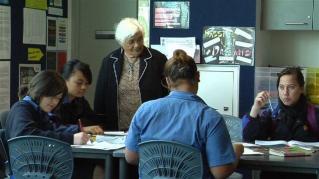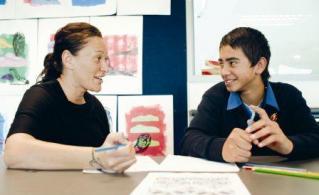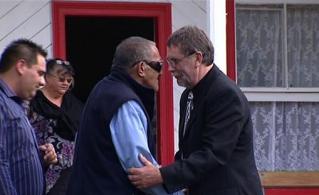Section navigation
The Cobden Primary School case study is part of the Te Kauhua case studies report (2010), prepared for the Ministry of Education by Dr Ruth Gorinski. As part of their action research for Te Kauhua phase 3, Cobden Primary School investigated how a tuakana-teina reading programme can enhance Māori learner literacy achievement and build teacher understanding of a Māori world view (te ao Māori).
Background
Cobden Primary School is a decile two school located on the West Coast of the South Island in Greymouth. It has a roll of 146 students of whom 24% identify as Māori. The majority of staff at Cobden School is non-Māori. Māori students however, comprise a quarter of the school roll. The school was involved in the Te Kauhua initiative between 2002 and 2006.
Research Question
How can a tuakana-teina reading programme enhance Māori learner literacy achievement and build teacher understanding of a Māori world view (te ao Māori)?
Impetus for the initiative
The impetus for the initiative was two-fold. First, there were identified gaps in teachers’ literacy pedagogical knowledge. Second, there were also gaps in teachers’ understanding, knowledge, and practice of the principles underpinning te ao Māori. Teachers expressed a desire to better understand their Māori students and meet their learning needs. They also wished to meet the aspirations of the Cobden Māori community.
What was done?
The school adopted a tuakana-teina approach to supporting literacy development and broadening teachers’ understanding of te ao Māori. Two professional learning workshops were held to help raise teacher capability in addressing the identified concern. The first workshop focused on growing teachers’ knowledge and understanding of te ao Māori principles and developing a shared understudying of what a Māori world view means.
The second workshop sought to develop staff understandings around the tuakana-teina approach to reading. Over an informal dinner, local community Māori personnel spoke about te ao Māori and the tuakana- teina concept. To establish some baseline data about teacher’s prior knowledge of the tuakana-teina kaupapa, teachers were given pre and post-dinner questionnaires to complete. This provided invaluable guidance for the following stages of the action plan.
For implementation purposes, senior class students buddied up with junior class students as tuakana – teina pairs, with the exception of one class. Because of an odd number of classes, one class did tuakana-teina pairing within the class. That teacher buddied up younger children with older children in the class.
Much of the initial implementation time was used organizing the tuakana and teina, leaving minimal time for reading. However, teachers recognised the need for buddies to build relationships so that they would feel comfortable reading with each other. Teachers found that the most successful tuakana-teina pairings were those who developed a positive relationship from the start. In order to help younger teina remember who their tuakana was, teachers gave each child a photograph of the buddies working together.
Once children were settled in the tuakana-teina pairs, teachers worked to address off task behaviour by making the reading sessions more structured. The development of buddy reading cards and strategy strips helped with this structure. The cards gave the tuakana and teina an idea of what was expected of them in the reading sessions, and modelled the kind of questions or comments they could use.
Four Māori students from each class were tracked for data gathering purposes. Teachers recorded their observations, weekly reflections and student reflections in their action research logs. STAR results were reviewed and analysed and there were ongoing discussions amongst colleagues as well as with students about the achievement data.
What was the impact on student learning and achievement?
- The data highlight the development of relationships and interactions between tuakana and teina. Concurrent with this was an increase in student’s learning and confidence: “My tuakana teina has helped me by making me more confident when reading out loud.”
- Comments from year 8 students about their teina, exemplified the reciprocal nature and benefits of the relationships: “I think tuakana - teina is a great thing and I love to go down and teach my teina.”
- STAR results evidenced a marked improvement in students' vocabulary and comprehension levels.
Key learning
- In order for teachers to become effective ‘agents of change’ it is necessary for them to learn new approaches to teaching, for example, peer and group learning and an understanding of Te Reo Māori and tikanga, to facilitate enhanced relationships with Māori learners.
- Student co-construction of learning, the provision of feedback and feed forward, and building positive and effective relationships with Māori students, is key to their success.
- Professional development needs to be regular and focused to effect sustainable change.
Challenges and opportunities
- Staff changes and maintaining momentum when individualised professional learning is needed, particularly with foreign teachers.
- Ensuring the focus stays on quality learning and relationships rather than quantity.
- Encouraging staff to move beyond their comfort zones can be threatening and create dissonance that needs to be carefully managed.
Reflective questions
- How can I as a leader, help identify the specific gaps in teachers' knowledge and understanding of te ao Māori and ensure appropriate professional learning is provided to strengthen their practice?
- What role could whānau have in supporting the cultural development of staff?
Filed under: Productive partnerships | Effective teachers





